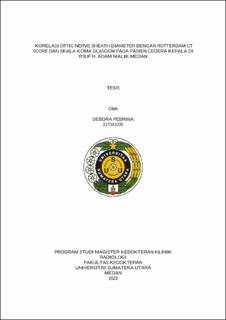Korelasi Optic Nerve Sheath Diameter dengan Rotterdam CT Score dan Skala Koma Glasgow pada Pasien Cedera Kepala di RSUP H. Adam Malik Medan

Date
2023Author
Febrina, Debora
Advisor(s)
Lubis, Netty D.
Arsyad, Abdurrahman Mousa
Metadata
Show full item recordAbstract
Background: Head injury is one of the causes of morbidity and mortality throughout the
world. Increased intracranial pressure (ICP) is one of the fatal events resulting from head
injury. The gold standard examination for diagnosing elevated ICP, namely external
ventricular drainage (EVD), is highly invasive, not available in the initial assessment, and
is contraindicated in patients with coagulopathy. Measuring optic nerve sheath diameter
(ONSD) has recently emerged as an alternative, non-invasive method of ICP monitoring.
Based on initial CT scan findings, the Rotterdam CT Score (RCTS) is used to assess the
severity and prognosis of head injury. A high Rotterdam CT Score is associated with a
higher mortality rate and this has been proven in various studies.
Objective: To analyze the correlation between ONSD with RCTS and GCS.
Methods: Cross-sectional study of head injury patients who underwent non-contrast head
CT scans at the Radiology Departement of RSUP H. Adam Malik, Medan from May 1st,
2022 to April 30th, 2023 who met the inclusion criteria. Then ONSD and RCTS
measurements were carried out on non-contrast head CT scans by 2 examiners. The GCS
score is obtained from the patient's medical record.
Results: From 42 patients studied, the number of male samples was 61.9%. The mean
age is 36.33 ± 12.47 years with the largest age group being 18 – 30 years. The mean
ONSD was 6.26 ± 0.80 mm. The median score of RCTS was 3(1-6) and GCS was 14 (3
– 15). There is a significant strong positive correlation between ONSD and RCTS (r =
0.747) and a moderate negative correlation between ONSD and GCS (r = -0.476) with
p<0.05.
Conclusion: There is a strong positive correlation between ONSD and RCTS and a
moderate negative correlation between ONSD and GCS.
